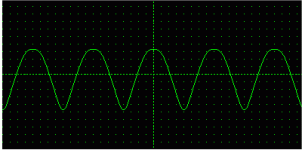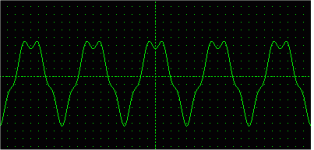Same THD level in fig. (b) and (c)
We can expect seriously clipped waveforms from the blameless amplifiers due to a high content of high- and odd-order harmonics.
ANY clipped waveform has a high content of harmonics. Is there a point to your post?
jan didden
Nope... Misconception....Time shift will not alter the wave form......Tried to subtract two sines with 10 degrees time shift in LT-spice.. looked at the resulting waveform.. Still a sine No distortion (at -240 DdB's) hmmm
But, if the signal curve has a non-periodic arbitrary shape, will it be the same with the delay and subtraction ?
Furthermore,
Where did I mention feedback?He is fundamentally wrong and he doen't understand feedback.
You can`t cancel any sine wave by any means.If you have a 1V 1kHz sine and partially cancel it with a 0.9V 1kHz sine you still have nothing more than a 1kHz sine.
Jan
do fig. (b) and (c) look the same to you?
Of course not, you think I'm blind? Is there a point to THIS question of yours?
jan
Also,
I was not talking about feedback having symmetry.
I was talking about mathematical functions, sinusoidal waves, signal transmissions and distortions having symmetry.I think WuYit says that when you start using any kind of symmetry or feedback to lower distortion or non linearities you just switch the problem to a higher order..as theres no such thing as perfect cancellation...
I was not talking about feedback having symmetry.
It will.Time shift will not alter the wave form......
But, if the signal curve has a non-periodic arbitrary shape, will it be the same with the delay and subtraction ?
If you make the assumption that all arbitrary curves can be described as a summation off sines with different frequency and amplitudes, then yes It will remain the same...
Tried to make a three tone (1,10,100 KHz) FFT.. on an amplifier concept I'am currently working on....
http://www.diyaudio.com/forums/solid-state/184211-my-vas-performance-never-let-me-down-3.html (post29)
If you plot that wave form you have something that looks very arbitrary...and a good picture on what happens....as the summation of the 3 tones creates sub bands to the sides of the fundamentals...
If you then look at your concept with the follower, then my belief in why it excels is not only the single ended approach, but the fact that it is so well isolated from the supply caps....(The two string version will be unbeatable🙂
When building amplifiers we look so much at the amplifier and topology...that we tend to forget about the PSU and look too much at minute distortion numbers... On normal amplifiers we look at GND as being a reference point for the speaker load...As all currents flow through the GND.. It's totally vital that it is firm and totally solid, But often it is not, as it can be no better than the capacitance supporting it...!!
If you by "high content of harmonics" mean high content of harmonic distortion products, then that content in fig. (b) and (c) is the same, yet the waveform in fig. (b) is not clipped, showing that clipped waveforms do not necessarily have a "high content of harmonics".ANY clipped waveform has a high content of harmonics.
If you by "high content of harmonics" mean high content of harmonic distortion products, then that content in fig. (b) and (c) is the same...
So the caption of that figure is incorrect? What is the correct caption?
If you by "high content of harmonics" mean high content of harmonic distortion products, then that content in fig. (b) and (c) is the same, yet the waveform in fig. (b) is not clipped, showing that clipped waveforms do not necessarily have a "high content of harmonics".
Your reasoning is in error. What is shows is that waveforms can have a harmonic content without being clipped. Which is opposite to what you say. It is also something that is trivial and well known. Still no point?
jan
Hi SY,
the caption is correct, the THD level in fig. (b) and (c) is the same, but the distortion level of the harmonic orders is different, showing the problem with the THD metric.
the caption is correct, the THD level in fig. (b) and (c) is the same, but the distortion level of the harmonic orders is different, showing the problem with the THD metric.
We can expect seriously clipped waveforms from the blameless amplifiers due to a high content of high- and odd-order harmonics...
...the caption is correct...
Then if the caption is correct, you aren't. The waveforms have enormously different harmonic content. And since, experimentally, "blameless" amps don't show waveforms like that, your hypothesis is falsified. That's the point at which the honest practitioner says, "Oops!" and tosses his hypothesis into the trash.
Back to the drawing board!
I am getting close to the point of skimming past any Wuyit post.
There is so much confusion in his posts, some of it being deliberately buried in science, that I can learn nothing from his contributions.
There is so much confusion in his posts, some of it being deliberately buried in science, that I can learn nothing from his contributions.
You have the option to ignore or respond. Up to you. Announcing that you're not going to respond is not exactly productive.😀
It's not for the option to ignore or respond to his posts.
I would need to read them to make that choice.
The opinion I'm expressing is that not reading could be a better option.
That opinion should not be stiffled. Particularly if there are some sitting on the fence wondering if it might be possible that Wujit's posts contain some real information that is worth reading/learning/saving for later.
So far on the evidence available, I can reach two tentative conclusions.
1). some of the content in his posts are wrong.
2.) all of the remainder are beyond my comprehension.
I would need to read them to make that choice.
The opinion I'm expressing is that not reading could be a better option.
That opinion should not be stiffled. Particularly if there are some sitting on the fence wondering if it might be possible that Wujit's posts contain some real information that is worth reading/learning/saving for later.
So far on the evidence available, I can reach two tentative conclusions.
1). some of the content in his posts are wrong.
2.) all of the remainder are beyond my comprehension.
Last edited:
You have an ignore button. Use it or not as you wish, but please don't drag this thread off topic.
WuYit's B and C seem to be the same even order products. In my tinkerings , hooking output stages to electric range calrods , I have seen these non-linearities in the voltage stage (VAS). To make the point , he left out what a odd order non-linearity looks like.
Generated with this applet : Guitar Distortion 101
(below 1) = H2 added to fundamental. (WuYit's B)
(below 2) = H2 and 4 (WuYit's C)
(below 3) = H3 (odd)
A clipping output stage usually does not just contribute these lower order components. A "sagging" OPS with insufficient current gain will , by loading the VAS. (done this with my CRO and calrods). Switching distortion and clipping are rich in higher order products. It is real interesting to see what TMC does to each of these shortcomings in a blameless. 🙂
OS
Generated with this applet : Guitar Distortion 101
(below 1) = H2 added to fundamental. (WuYit's B)
(below 2) = H2 and 4 (WuYit's C)
(below 3) = H3 (odd)
A clipping output stage usually does not just contribute these lower order components. A "sagging" OPS with insufficient current gain will , by loading the VAS. (done this with my CRO and calrods). Switching distortion and clipping are rich in higher order products. It is real interesting to see what TMC does to each of these shortcomings in a blameless. 🙂
OS
Attachments
It's not for the option to ignore or respond to his posts.
I would need to read them to make that choice.
The opinion I'm expressing is that not reading could be a better option.
That opinion should not be stiffled. Particularly if there are some sitting on the fence wondering if it might be possible that Wujit's posts contain some real information that is worth reading/learning/saving for later.
So far on the evidence available, I can reach two tentative conclusions.
1). some of the content in his posts are wrong.
2.) all of the remainder are beyond my comprehension.
Some of his text is verbatim cut-&-past from elsewhere, like wikipedia. Some of it is factually correct, but because he a) doesn't understand what it means and b) buries it in a lot of pseudo-babble means it's more confusing than anything else.
It's the technical equivalent of leaving a baby alone with an open razorblade. Scary. Tough. 😉
jan
Wuyit....
Are you trying to say that the higher order harmonic content should be as low as possible...
and that 1% second order with no higher order is better than 0.001% total harmonic distortion with some higher order harmonics....??
I don't see the point in what you're trying to tell. apart from the fact that you only see single ended designs as valid for sound reproduction...and yet there you ignore the differences there is in the Vladimir (Andrea Ciuffoli) concept and the Pavel Macura concept...
Are you trying to say that the higher order harmonic content should be as low as possible...
and that 1% second order with no higher order is better than 0.001% total harmonic distortion with some higher order harmonics....??
I don't see the point in what you're trying to tell. apart from the fact that you only see single ended designs as valid for sound reproduction...and yet there you ignore the differences there is in the Vladimir (Andrea Ciuffoli) concept and the Pavel Macura concept...
- Status
- Not open for further replies.
- Home
- Amplifiers
- Solid State
- Constant Current Pros and Cons



